Gallery of Restored Locks and Dams
Morris Dam, California
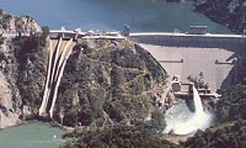
In 2006 Abhe & Svoboda, Inc. renovated of three radial drum gates and four manually operated slide gates.
Each of the 70 foot long drum gates had a radius of 21 feet, and required UT testing and steel repairs, as well as abrasive blasting and painting.
Abrasive blasting and painting of the complete exteriors and partial interiors of the three gates was conducted. SSPC Class 1A containments were erected. SSPC-SP 10 Near White Metal Blast with recyclable steel grit was the abrasive blast cleaning method used. The paint system spray-applied to the exterior steel surfaces of the gates was Tnemec Coatings Pota-Pox Plus epoxy. The interiors were coated with Tnemec-Tar coal tar epoxy.
To repair the four operated slide gates, they were first removed. New bronze seals were machined and installed to replace the worn-out seals on the gates and imbeds. The cast-iron slide gates were also blasted and painted with an epoxy coating. The gates were then replaced and retrofitted with new electric motor operated actuators.
The project also required the fabrication and installation of new stainless steel butterfly seals, clamp bars, brackets, and hardware. The mechanical work consisted of replacement of the inlet/outlet valves and piping with new 16" motor operated plug valves, and 18" motor operated knife gate valves.
The project was completed on schedule.
Lovewell Dam, Kansas
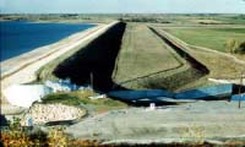
In 2004 Abhe & Svoboda, Inc. performed rehabilitating work to the Lovewell Dam regulating gates, and fabricated and installed new intake bulkhead gates.
SSPC Class 1A containments were erected utilizing Etobicoke® system Scaffolding. The abrasive blast cleaning method used to prepare steel surfaces was SSPC-SP 10, Near White Metal Blast with Black Beauty Coal Slag and Blastox additive abrasive.
The paint system that was spray applied to the exterior steel surfaces of the spillway radial gates, radial check gates, radial waste gate, and newly fabricated intake bulkhead gates was a Sherwin Williams moisture-cured urethane system (Corothane-I Galvapac One Pack Zinc primer, Corothane-I Ironox B intermediate, and Corothane-I Ironox A topcoat). Another Sherwin Williams moisture cure urethane paint system was applied to the fixed-wheel emergency gate, high head regulating radial gate and outlet sluice gate (Corothane-I Zinc primer, Corothane Coal Tar intermediate, and Corothane-I Coal Tar topcoat).
Underwater diving work was required for the setting of the new bulkhead gates. Divers cleaned the sill and ensured the bulkhead gates fit in the slots and properly sealed prior to de-watering the outlet channel. A 30 ton rough terrain crane was used to set the newly fabricated bulkhead gates.
The project had a very strict construction schedule. The Lovewell Reservoir was lowered below the spillway gate sill elevation to allow complete un-watered access to the upstream side of the spillway gates. The work was required to be completed during a shutdown period from September 15th and December 15th.
SSPC Class 1A containments were erected utilizing Etobicoke® system Scaffolding. The abrasive blast cleaning method used to prepare steel surfaces was SSPC-SP 10, Near White Metal Blast with Black Beauty Coal Slag and Blastox additive abrasive.
The paint system that was spray applied to the exterior steel surfaces of the spillway radial gates, radial check gates, radial waste gate, and newly fabricated intake bulkhead gates was a Sherwin Williams moisture-cured urethane system (Corothane-I Galvapac One Pack Zinc primer, Corothane-I Ironox B intermediate, and Corothane-I Ironox A topcoat). Another Sherwin Williams moisture cure urethane paint system was applied to the fixed-wheel emergency gate, high head regulating radial gate and outlet sluice gate (Corothane-I Zinc primer, Corothane Coal Tar intermediate, and Corothane-I Coal Tar topcoat).
Underwater diving work was required for the setting of the new bulkhead gates. Divers cleaned the sill and ensured the bulkhead gates fit in the slots and properly sealed prior to de-watering the outlet channel. A 30 ton rough terrain crane was used to set the newly fabricated bulkhead gates.
The project had a very strict construction schedule. The Lovewell Reservoir was lowered below the spillway gate sill elevation to allow complete un-watered access to the upstream side of the spillway gates. The work was required to be completed during a shutdown period from September 15th and December 15th.
Parker Dam, Arizona
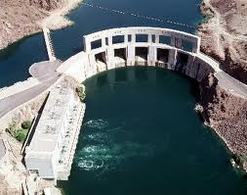
In 2002 Abhe & Svoboda, Inc. performed rehabilitating work to the Parker Dam. The 320 foot high dam is not the tallest dam in the world, but is considered to be the "deepest" because 235 feet of the structure is below the riverbed. The massive reservoir created by Parker Dam, Lake Havasu, holds 210 billion gallons of water. Located on the Arizona/California border, Lake Havasu is the water source for both the Central Arizona Project Aqueduct and the Colorado River Aqueduct, which supply the water for Phoenix, Tucson, and practically every city in the greater Los Angeles - San Diego area.
This project involved abrasive blasting and painting of five 50 foot x 50 foot regulating lift gates. Abhe & Svoboda, Inc. operated a large floating bulkhead to de-water each regulating gate bay. SSPC Class 1A containments were erected utilizing a BEECHE platform under each gate and Etobicoke® system scaffolding up and down stream of each gate. The abrasive blast cleaning method used to prepare the steel surfaces was SSPC-SP 10, Near White Metal Blast with recyclable steel grit abrasive. Amerlock 400 and Amercoat 450 HS by Ameron Coatings was spray applied to all steel surfaces of the gates.
Additionally, Abhe & Svoboda, Inc. removed and replaced gate seals, clamping bars, and other hardware. The gate roller train assemblies were also removed, refurbished and reinstalled.
There were 27 contract modifications on this project, yet the work was completed 6 months ahead of schedule and without any injuries.
This project involved abrasive blasting and painting of five 50 foot x 50 foot regulating lift gates. Abhe & Svoboda, Inc. operated a large floating bulkhead to de-water each regulating gate bay. SSPC Class 1A containments were erected utilizing a BEECHE platform under each gate and Etobicoke® system scaffolding up and down stream of each gate. The abrasive blast cleaning method used to prepare the steel surfaces was SSPC-SP 10, Near White Metal Blast with recyclable steel grit abrasive. Amerlock 400 and Amercoat 450 HS by Ameron Coatings was spray applied to all steel surfaces of the gates.
Additionally, Abhe & Svoboda, Inc. removed and replaced gate seals, clamping bars, and other hardware. The gate roller train assemblies were also removed, refurbished and reinstalled.
There were 27 contract modifications on this project, yet the work was completed 6 months ahead of schedule and without any injuries.
Black Canyon Dam, Idaho
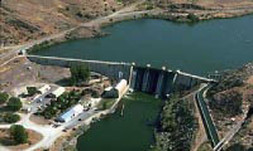
2001 Abhe & Svoboda, Inc. rehabilitated the three drum gates of the Black Canyon Dam. Each of the drum gates are 64 feet x 14.5 feet.
The drum gates and pier plates were abrasive blasted using recyclable steel grit abrasive. SSPC Class 1A containments were erected utilizing a BEECHE platform and Etobicoke® System Scaffolding. Blasting operations involved work in extreme confined spaces. The paint system that was spray applied to the exterior skin plate surfaces of the drum gates was Wasser High Tech Coatings Moisture Cure Zinc/Polyurethane System (MC Zinc primer, MC Ferrox B intermediate, and MC Ferrox A topcoat).
After the gate steel surfaces were abrasive blasted, the gates were inspected for proper surface preparation. During this inspection a major problem was encountered with the drum gate bronze aluminum hinge pins. Several 3" diameter hinge pins were broken. A change order was issued to remove and replace all of the 17 broken hinge pins. Special hardware removal procedures and expedited pin fabrication were required to completed the project on schedule.
The project had a very strict construction schedule. The work was performed during a shut down period from October through March. The reservoir was lowered to allow work on the drum gates in an un-watered state. All of the work was required to be completed before March when the shut down period was over and spring runoff water from the mountains raised the reservoir water level. The project was completed in early March, almost a full month ahead of schedule.
The drum gates and pier plates were abrasive blasted using recyclable steel grit abrasive. SSPC Class 1A containments were erected utilizing a BEECHE platform and Etobicoke® System Scaffolding. Blasting operations involved work in extreme confined spaces. The paint system that was spray applied to the exterior skin plate surfaces of the drum gates was Wasser High Tech Coatings Moisture Cure Zinc/Polyurethane System (MC Zinc primer, MC Ferrox B intermediate, and MC Ferrox A topcoat).
After the gate steel surfaces were abrasive blasted, the gates were inspected for proper surface preparation. During this inspection a major problem was encountered with the drum gate bronze aluminum hinge pins. Several 3" diameter hinge pins were broken. A change order was issued to remove and replace all of the 17 broken hinge pins. Special hardware removal procedures and expedited pin fabrication were required to completed the project on schedule.
The project had a very strict construction schedule. The work was performed during a shut down period from October through March. The reservoir was lowered to allow work on the drum gates in an un-watered state. All of the work was required to be completed before March when the shut down period was over and spring runoff water from the mountains raised the reservoir water level. The project was completed in early March, almost a full month ahead of schedule.
MacArthur Locks, Michigan
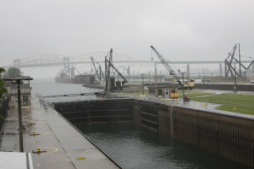
In 1999 Abhe & Svoboda, Inc. performed rehabilitating work to the MacArthur Locks - a system of channels, canals, and waterways make the Great Lakes accessible to the Atlantic Ocean, and every year hundreds of millions of tons of cargo are transported through the Great Lakes region.
Between Lake Superior and Lake Huron is a series of locks known as the Sault Locks. The Sault Locks, which include MacArthur Lock, are the busiest in the world, despite the lakes being frozen and closed to shipping for three months each winter. During winter months the locks are drained and maintenance is performed during an annual shutdown period from December 15th - March 15th. In the winter of 1998/1999 Abhe & Svoboda, Inc. performed major renovations on MacArthur Lock.
The MacArthur lock is 800 feet long, 80 feet wide and 30 feet deep, and large enough to handle ocean going vessels. The project involved extensive concrete repairs to the south wall and vertical monolith joints. The concrete repairs consisted of saw cutting around the perimeter of the marked repair areas, chipping out the concrete to a depth of 12 inches, preparing the substrate surface, and forming and pouring the repair areas with a fiber reinforced acrylic polymer modified concrete. Following concrete repairs, the monolith joints were injected with hydrophobic polyurethane resin foam grout, and sealed with an elastomeric joint sealant.
During removal of the initial concrete monolith joint, a lead water stop was discovered within the joint, so a change order was issued to excavate the monolith joints the full length of the lock wall to remove all the lead stops. The original contract was designed to excavate the joints halfway down the vertical lock wall, therefore the change doubled the quantity of monolith joint that needed to be removed and replaced within the original contract time.
In addition to the concrete repair, abrasive blasting and painting of four lock tainter valve gates, three overlook platforms, and two lock fender booms was performed. Miscellaneous steel repairs were also done, including the removal and replacement of more than 650 steel machinery cover plates, and repairs of damaged/corroded lock wall ladders.
About 85% of the work was completed during the winter shut down period of December 15th - March 15th. The remaining work, which involved blasting and painting the tainter valve gates, was performed without interfering with river traffic. The remaining blasting and painting operations took place inside the tainter valve gate chambers within the confined spaces of the lock monolith walls.
Despite the major change orders the MacArthur Locks renovation project was finished ahead of schedule and without any injuries.
Between Lake Superior and Lake Huron is a series of locks known as the Sault Locks. The Sault Locks, which include MacArthur Lock, are the busiest in the world, despite the lakes being frozen and closed to shipping for three months each winter. During winter months the locks are drained and maintenance is performed during an annual shutdown period from December 15th - March 15th. In the winter of 1998/1999 Abhe & Svoboda, Inc. performed major renovations on MacArthur Lock.
The MacArthur lock is 800 feet long, 80 feet wide and 30 feet deep, and large enough to handle ocean going vessels. The project involved extensive concrete repairs to the south wall and vertical monolith joints. The concrete repairs consisted of saw cutting around the perimeter of the marked repair areas, chipping out the concrete to a depth of 12 inches, preparing the substrate surface, and forming and pouring the repair areas with a fiber reinforced acrylic polymer modified concrete. Following concrete repairs, the monolith joints were injected with hydrophobic polyurethane resin foam grout, and sealed with an elastomeric joint sealant.
During removal of the initial concrete monolith joint, a lead water stop was discovered within the joint, so a change order was issued to excavate the monolith joints the full length of the lock wall to remove all the lead stops. The original contract was designed to excavate the joints halfway down the vertical lock wall, therefore the change doubled the quantity of monolith joint that needed to be removed and replaced within the original contract time.
In addition to the concrete repair, abrasive blasting and painting of four lock tainter valve gates, three overlook platforms, and two lock fender booms was performed. Miscellaneous steel repairs were also done, including the removal and replacement of more than 650 steel machinery cover plates, and repairs of damaged/corroded lock wall ladders.
About 85% of the work was completed during the winter shut down period of December 15th - March 15th. The remaining work, which involved blasting and painting the tainter valve gates, was performed without interfering with river traffic. The remaining blasting and painting operations took place inside the tainter valve gate chambers within the confined spaces of the lock monolith walls.
Despite the major change orders the MacArthur Locks renovation project was finished ahead of schedule and without any injuries.
